
The Dinosaur Collector;
The Late Triassic Carnian - Norian,
220 million years ago the dinosaurs get ready to dominate. This chapter of Walking with Dinosaurs is called aptly The New Blood. updated 11/21/07
Triassic Diorama pages More Diorama
Placerias the last of the dicynodonts plays the tragic role in the show. These animals are not dinosaurs but related to mammals. The dicynodonts dominated the last of the Permian and the first half of the Triassic. Walking with Dinosaurs portrays these animals as doomed relics poorly adapted to the hot dry climates of the Late Triassic. Although their ancestors were the most successful survivors of the Late Permian extinction when the climate was probably even more extreme. The change in vegetation may have been a more critical factor, or just bad luck, in their extinction. There is a bias in popular thinking that says survivors must have some natural evolutionary advantage over a species that dies out. So we construct these scenarios finding reasons why dinosaurs out competed their contemporaries. The same thing happens at the end of the Cretaceous when dinosaurs are snuffed out and there are all the theories developed proving mammals were superior. There were a series of extinctions in the Late Triassic that seemed to clear the stage for the dinosaurs to fill up the world. Which they did very spectacularly.

A Placerias from a dollar store bin donated by Sean Bell and a Tyco Placerias from the Dino Rider series.
One of the last stands of Placerias is the American southwest. Over 40 fossils of this 1 ton animal have been found in the Petrified Forest of Arizona. Current thought is Pangaea was a environment that alternated between super monsoons and extreme aridity. Periodically the monsoons fail as the the movement of the plates disrupts the weather patterns and the flora and fauna is decimated. After each drought Placerias is slow to recover and eventually dies out.. Postosuchus is adapted to preying on Placerias so as Placerias goes so does Postosuchus.
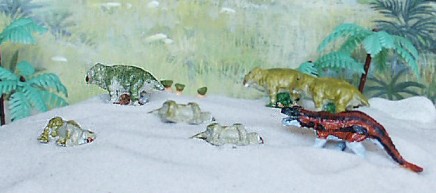
The QRF (Quick Reaction Force) Survive A Saurus Placerias carcass's and live Placerias. The Ral Partha figure most resembles Postosuchus. It has been referred to as Erythosuchus from the Early Triassic or Ticinosuchus from Middle Triassic. It was sold by Ral Partha labeled Small Carnosaurs 13-004 part of the Children of the Night along with Dimetrodon and Sphenacodon..
Phytosaurs don't show up in the documentary but are mentioned in a scene from the book. Their fossils are found in the northern part of Pangaea, Laurasia. They are not closely related to alligators or crocodiles but resembled them superficially except that the nostrils are set in front of the eyes rather than at the end of the snout. Rutiodon one of the biggest must have been a top predator much like the large crocodiles of Australia and South America feeding on a variety of other reptiles. Teeth have been found in the petrified forest in Arizona. The book suggests that the phytosaurs dependence on water meant their extinction. They are described as rotting in their dried up ponds. The ancestors of alligators were evolving in the southern part of Pangaea, Gondwanaland. Perhaps the droughts were less extreme there or they had not become as committed to an aquatic life style as they would later. Either way they survived the Triassic but phytosaurs didn't.
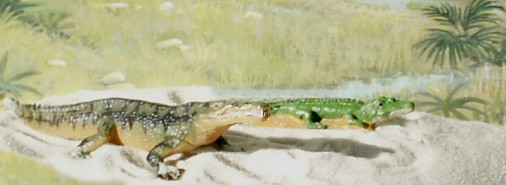
The phytosaur Rutidon from The UHA series by Kaiyodo. Further back is a Phytosaurus from QRF.
Coelophysis the medium size dinosaur waiting to inherit the Mesozoic is the hero of the New Blood chapter.. This animals represents the basic body plan for theropods through the Mesozoic. It was very successful and the design was modified but retained by the latter giants in the Jurassic and Cretaceous. You could still find small theropods in the last of the Mesozoic that looked pretty much the same.
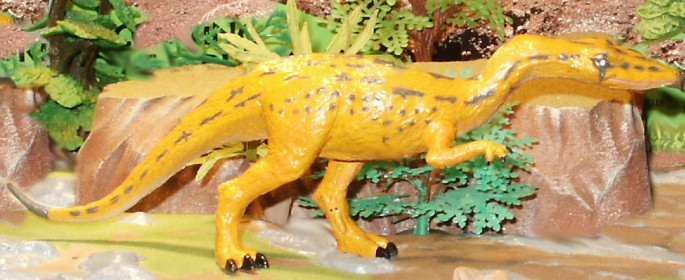
Coelophysis from TS Toys donated by the Dinosaur Farm. These are very hard to find and the maker made an effort to pick alternate names for the figures. This one was labeled Eoraptor.
The dominate predators were archosaurs like Postosuchus. Walking with Dinosaurs has Postosuchus as a solitary ambush predator. It had legs directly under the body unlike modern lizards and an ankle design that differed from both dinosaurs and crocodiles. It probably laid in wait on game trails for prey like modern Komodo dragon or crocs do. It could then take out a nasty chuck of of flesh, killing smaller animals or wounding larger animals fatally and then waiting for them to die from the blood lose and infection. It should be noted that while crocs and Komodo are not social pack animals in the mammal sense, they do seem be able to live in close association with other members of their kind. So Postosuchus might not have been as solitary as the show implies. One notable scene has the Postosuchus spraying the boundaries of its territory like a modern lion. I think a certain amount of skepticism needs to be applied here. First birds and lizards don't produce urine like a mammal. They excrete a slurry as seen in pigeons. This reduces their water requirements compared to mammals a difference stressed in the show. I think it that if Postosuchus scent marked its territory, specialized glands might have been a possibility but birds and crocs vocalize to mark their territories so maybe we should have a singing Postosuchus. It could be a Disney musical.

Toyway Postosuchus from the Walking with Dinosaurs series. K&M Coelophysis custom painted by Stephen Robertson.
The term "cynodont" refers to a broad group of
extinct animals, the Cynodontia. The Cynodont from the show is based on
the two molar teeth of a large cynodont found in Arizona. The animal in New
Blood is a scaled up version of he cynodont Thrinaxodon that lived in the Early
Triassic.
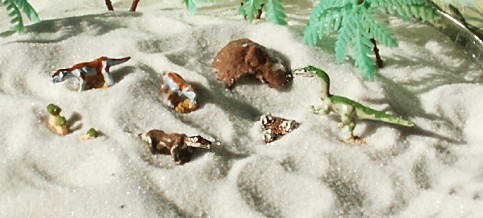
Cynodonts and babies from QRF. The cave and Coelophysis are also from QRF.
Coelophysis (hollow form), is known from dozens of skeletons found at Ghost Ranch in New Mexico. It seems to been a common hunter and came in a robust and gracile form interpreted as variation between males and females. Postosuchus has been found all over the Triassic of the American southwest. In the video Postosuchus is wounded in a territorial confrontation with another Postosuchus. In the book it takes a wound from the tusks of Placerias. In both the dying animal is scavenged by a pack of Coelophysis.
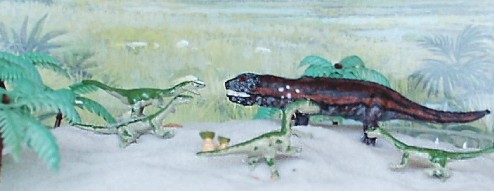
QRF provides 3 different Coelophysis. The QRF Postosuchus was painted by Stephen Robertson.
The prosauropod Plateosaurus (flat lizard) shows up in the final scene as the precursor to the giants of the Jurassic. One of the best known dinosaurs, from over a hundred skeletons, it was a large animal over 24 feet in length. It may have lived in groups and was wide spread in Laurasia. Prosauropods appear in the Triassic possibly as early as the Middle Triassic, dominate in the Early Jurassic and mysteriously disappear in the Middle Jurassic. Often they are described as the ancestors of the sauropods like Apatosaurus and Brachiosaurus. This seems unlikely as several early sauropods from the Triassic have been recently found. Prosauropods continue to diversify in the Early Jurassic developing into many smaller sized species.
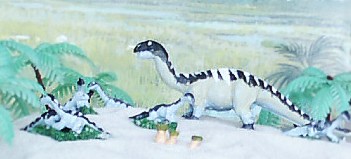
Plateosaurus and podlets from QRF.
The Coelophysis Quarry from the American Southwest seems the most likely source for the show. The dating is unsure and the time scale telescopes events. It is not older than very Late Carnian and could be as young as Rhaetian. Treating it as a Norian remnant of the Carnian fauna seems safe.
|
First Dinosaurs |
Next Norian The Empire of the Prosauropods |
Go to Mesozoic Home or
 Click
on the Site A icon left for more diorama listed by location Click on the Site A
icon to the right for Dioramas organized by period or by manufacturer.
Click
on the Site A icon left for more diorama listed by location Click on the Site A
icon to the right for Dioramas organized by period or by manufacturer.